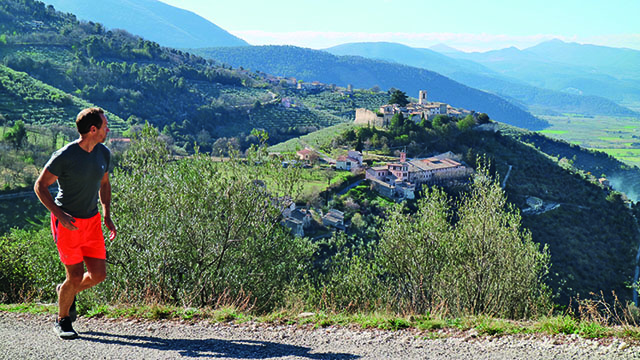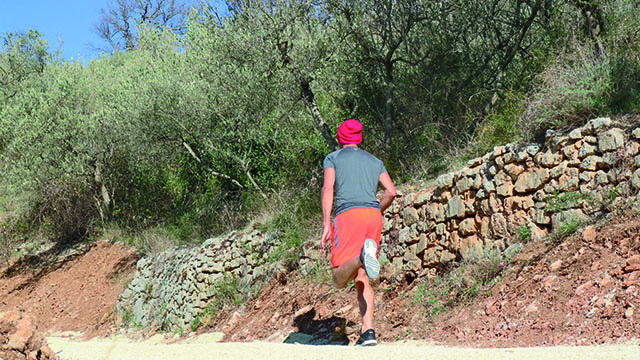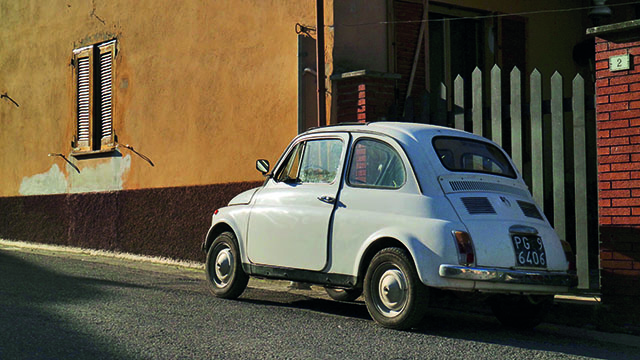RUNNING THE WORLD: Umbria, Italy
Umbria is quintessentially Italian: coffee, cathedrals and the perfect place to run. – By Ryan Scott
Name: Ryan Scott
Age: 42
Profession: RW Gear Editor
Unlike most other regions of boot-shaped Italy, Umbria has no border with the sea. It’s brown and cold in winter, but in spring and summer it transforms into the green heart of the country. Thousands of olive groves, and ancient hilltop towns, are among countless good reasons to run there…
Accessible
There are lots of fantastic landscapes in the world. The problem is, not all of them are accessible – fences, private land, government-owned areas and urban infrastructure often thwart our running-adventure ambitions.
Thankfully, an uninterrupted route spanning over 200km – between Assisi in the north, and Rome in the south – was established hundreds of years ago, as part of a Camino in honour of the revered religious figure St Francis of Assisi.
The patron saint of Italy was the first-ever ecologist, dedicated to the natural world of plants and animals. This exquisite, hilly route reflects St Francis’ foresight and passion. It’s free for all to enjoy, whether you plan on running from one town to another, or all the way from Assisi to Rome.
Original
On my journey I passed through historic hilltop towns such as Spello, Trévi, Campello Alto, and Spoleto. Each one has a cathedral, a monastery or convent, and atmospheric cobbled streets.
In every town square there is a coffee shop, where locals zip in for their morning shot of espresso (sometimes even a shot of grappa!) and exchange greetings at the tops of their voices.
Also in the square there is a regular market, selling fresh fruit, meat, plants, bread, and cheeses. This simple, healthy produce is best enjoyed drizzled in locally-produced olive oil. And the gelato, which you can buy in every town, is not to be missed.
Abundant with life
Running from one town to the next isn’t always easy. It’s not the terrain that’s the issue; rather, it’s the hilly topography, which requires some effort. I didn’t find it as tough as the intense trail running I’m used to in Cape Town – the average runner could handle it – but it was challenging enough to get my heart pumping.
The reward? Ascending the hills afforded me beautiful views of the valleys below. The hills in Umbria are decorated with millions of olive trees; the pungent amber nectar extracted from their fruit complements most local meals, and is a staple of the light Mediterranean diet.
The Camino runs right through some of the oldest olive groves in the area. In spring, pomegranates blossom proudly, and blood-red wild poppies are splashed over green fields. Picturesque towns, with mazes of tiled roofs and labyrinths of old streets, and renowned for their gelato and hearty meals, surround the flat, fertile Tiber River Valley.
Time stands still
Umbria is quintessentially Italian: time seems to have stopped, and there is a sense of balance between the people who live here and their surrounding environment.

Architectural style bleeds from the farm regions into the villages so seamlessly that town and country form one dynamic living space. Traditional stone and stucco walls, huge wooden beams and classic arches characterise the buildings in the lush, green farmlands.
The same raw materials of stone and sand are used in the towns, but ornate tiles add vibrancy to an otherwise uniform colour palette. The best part: there isn’t an advertising billboard in sight.
Then too there are Umbria’s impressive cathedrals, most revered of which is the one in the hilltop town of Assisi.
What’s a Camino?
The word ‘Camino’ literally means ‘the way’. In Spain, the famous Way of St James leads to the city of Santiago de Compostela, and in Italy, the Way of Assisi leads towards Rome, and culminates at St Peter’s in the Vatican City. You can start your Camino pilgrimage anywhere; but in Italy, typically, pilgrims begin in Florence. The full route, via Assisi, can be navigated by following blue and yellow markings, which have been scattered over the area like fairytale breadcrumbs.
Local knowledge
• In March and April, locals forage for wild asparagus. Over this period, the delicacy features on every restaurant menu.
• Take a walk through the steep, lush wood, close to Spoleto, and you’ll discover the convent of Monteluco. Legend has it both St Francis of Assisi and Michelangelo visited the convent, which has since been converted into a hotel.
• Mediterraneans eat slowly and for a long time, and they go big on olive oil.
• Everything shuts down for a riposo, an afternoon nap taken at around 2pm. Life resumes at around 4.
How to get there
Fly to Rome, then hop on the train to Spoleto. From Spoleto, it’s another hour on the train to Assisi. AirBnB options abound all over Italy, but you can also find simple and affordable accommodation in Umbria by visiting agriturismo.it.







